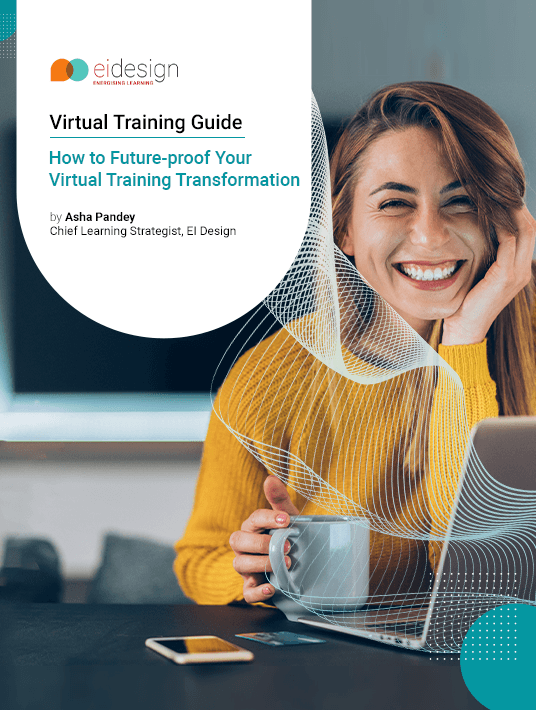Enhancing Virtual Training Programs With Immersive Self-Paced Learning
While delivering virtual training has been a significant part of corporate training, the COVID-19 crisis has clearly accelerated its need across the world. With travel restrictions and social distancing, L&D teams are looking at approaches to convert the classroom/ILT sessions to virtual trainings.

What Are The Options To Consider As You Convert Classroom/ILT Sessions To Virtual Trainings?
This virtual training transformation can be handled in 3 formats:
- Instructor-Led Training (ILT) to Virtual Instructor-Led Training (VILT) migration
Leveraging the platform to create the required impact and learning gain in the new mode. - Blended training
Building up the VILT sessions with components of self-paced, online training or mobile learning to arrive at the right blend. - Fully online (self-paced training)
Offering highly immersive learning approaches such as microlearning, mobile learning, gamification, and much more.
Remember
In your virtual training transformation from the classroom/ILT mode, you cannot map the classroom/ILT session “as is” to create an identical or better impact and improve virtual training efficiency.
Instead, you need to:
- Use effective digital pedagogy to manage your virtual training transformation.
- Identify which mode will work best (VILT/blended or self-paced, mobile-first/mobile-ready online courses).
- Leverage other strategies that create high motivation, participation, and engagement for remote learners—these could include simulations, gamification, 3D, Virtual Reality (VR), Augmented Reality (AR), and so on.
- Determine the training and learning effectiveness through online assessment strategies.
- Recommend delivery modes and platforms.
The transition to virtual training is a journey where the elements of training may shift gradually from primarily ILT to VILT or blended, and/or ultimately to a fully self-paced training mode.
In this article, I focus on maximizing the virtual training efficiency through 6 immersive self-paced learning strategies.
What Are The Key Benefits Of Self-Paced Virtual Training?
- Flexibility
You can learn when/where you want (especially from home!). - Scalability
It supports the learning needs of small as well as expanding, large remote workforces. - Adaptability
It is available on multiple learning devices, platforms, and operating environments. - Customization
It is easily configurable for different roles/responsibilities. - Personalization
It delivers unique training to each learner as opposed to a one-size-fits-all approach. - Multi-generational workforce support
Boomers, Gen-Xers/Yers, and Millennials can all create unique learning paths to support their individual learning styles.
What Immersive Virtual Learning Strategies Can You Use As You Opt For A Fully Self-Paced Online Mode?
To create effective and immersive virtual learning experiences, consider leveraging a learning and performance ecosystem-based approach for your workforce [1]. This mode works on the principle of continuous learning—rather than discrete learning—and provides value-adds to learners over distance.
Here are 6 immersive virtual learning strategies you can use as you opt for a fully self-paced online mode:
- Capture learners' attention regarding training opportunities. Leverage newsletters and teaser videos to highlight the significance of the initiative.
- Build awareness around "What’s In It For Me" (WIIFM). Highlight what value this training provides to the learners.
- For formal training, opt for immersive learning strategies like:
- Gamification
- AR/VR
- Scenario-based learning
- Interactive story-based learning
- Branching scenarios
- Complex decision-making simulations
- Augment formal training with performance support tools (PSTs) or job aids for knowledge application or to assist the learners at the moment of need.
- Post training,
- Reinforce learning to minimize knowledge erosion (addressing the forgetting curve)
- Continually challenge workers with more complex and advanced learning content
- Provide practice zones where learners can hone their skills
- Reconnect. Provide additional cues through related curated assets to keep the learning journey going.
- Offer social or collaborative learning opportunities so learners can learn through peer networking and other group forums—both within and outside of the work environment.
The unique capabilities of an immersive virtual learning experience help seamlessly connect learners with a broad array of learning content, best practice processes, and supporting tools. They provide a richer and more holistic approach to delivering virtual training, which helps enhance workforce performance.
I hope this article provides the required insights to maximize your virtual training efficiency with self-paced learning strategies. Download the eBook Virtual Training Guide: How To Future-Proof Your Virtual Training Transformation and discover all you need to know for your virtual training transformation endeavor—packed with tips, best practices, and ideas you can use! Join the webinar, too, and learn what is the ideal long-term approach for remote learners.
References:
[1] 5 Questions Answered That Prove You Should Invest In Learning And Performance Ecosystems

